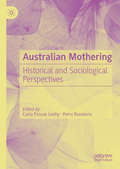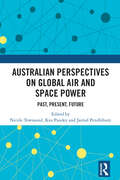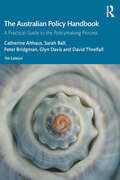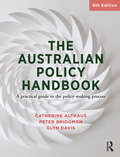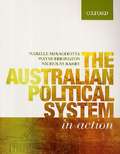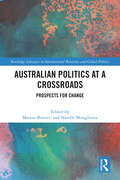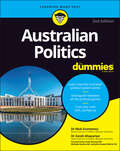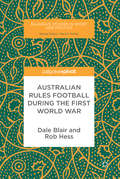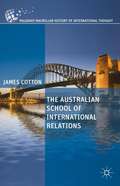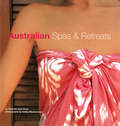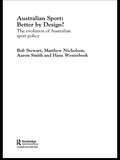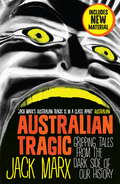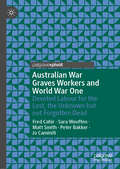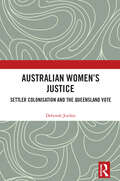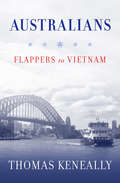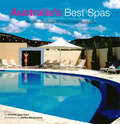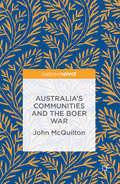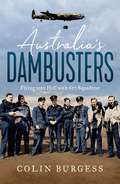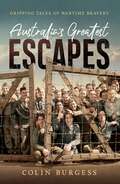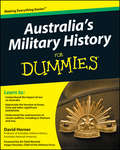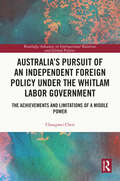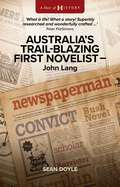- Table View
- List View
Australian Mothering: Historical and Sociological Perspectives
by Petra Bueskens Carla Pascoe LeahyThis collection defines the field of maternal studies in Australia for the first time. Leading motherhood researchers explore how mothering has evolved across Australian history as well as the joys and challenges of being a mother today. The contributors cover pregnancy, birth, relationships, childcare, domestic violence, time use, work, welfare, policy and psychology, from a diverse range of maternal perspectives. Utilising a matricentric feminist framework, Australian Mothering foregrounds the experiences, emotions and perspectives of mothers to better understand how Australian motherhood has developed historically and contemporaneously. Drawing upon their combined sociological and historical expertise, Bueskens and Pascoe Leahy have carefully curated a collection that presents compelling research on past and present perspectives on maternity in Australia, which will be relevant to researchers, advocates and policy makers interested in the changing role of mothers in Australian society.
Australian Perspectives on Global Air and Space Power: Past, Present, Future
by Nicole Townsend Kus Pandey Jarrod PendleburyThis book surveys historical and emerging global air and space power issues and provides a multidisciplinary understanding of the application of air and space power in the past and present, as well as exploring potential future challenges that global air forces may face. Bringing together leading and emerging academics, professionals, and military personnel from Australia within the field of air and space power, this edited collection traces the evolution of technological innovations, as well as the ethical and cultural frameworks which have informed the development of air and space power in the 20th and 21st centuries, and contemplates its future. It covers topics such as the insurgent use of drones, the ethics of air strikes, the privatisation of air power, the historical trajectory of air power strategy, and the sociological implications of an ‘air force’ identity. While many of the chapters use Australian-based case studies for their analysis, they have broader applicability to a global readership, and several chapters examine other nations’ experiences, including those of the United States, and the United Kingdom. This accessible, illuminating book is an important addition to contemporary air and space power literature, and will be of great interest to students and scholars of air power, air warfare, military and international history, defense studies, and contemporary strategic studies, as well as military professionals.
The Australian Policy Handbook: A Practical Guide to the Policymaking Process
by Catherine Althaus Sarah Ball Peter Bridgman Glyn Davis David ThrelfallThe seventh edition of this classic handbook on the policy process is fully updated, featuring new material on policy making amid local and global disruption, the contestable nature of modern policy advice, commissioning and contracting, public engagement and policy success and failure. The Australian Policy Handbook shows how public policy permeates every aspect of our lives. It is the stuff of government, justifying taxes, driving legislation and shaping our social services. Public policy gives us roads, railways and airports, emergency services, justice, education and health services, defence, industry development and natural resource management. While politicians make the decisions, public servants provide analysis and support for those choices. This updated edition includes new visuals and introduces a series of case studies for the first time. These cases—covering family violence, behavioural economics, justice reinvestment, child protection and more—illustrate the personal and professional challenges of policymaking practice. Drawing on their extensive practical and academic experience, the authors outline the processes used in making public policy. They systematically explain the relationships between political decision makers, public service advisers, community participants and those charged with implementation. The Australian Policy Handbook remains the essential guide for students and practitioners of policy making in Australia.
The Australian Policy Handbook: A practical guide to the policy making process
by Glyn Davis Catherine Althaus Peter BridgmanPublic policy permeates every aspect of our lives. It is the stuff of government, justifying taxes, driving legislation, and shaping our social services. Public policy gives us roads, railways and airports, emergency services, industry development, and natural resource management. While politicians make the decisions, public servants provide analysis and support for those choices.Drawing on their extensive practical experience, the authors outline the processes used in making public policy. They systematically explain the relationships between political decision-makers, public service advisers, other community participants, and those charged with implementing the programs that result.The sixth edition of this widely used introduction is fully updated, and includes new material on the professionalisation of politicians, the role of opposition members, loss of corporate memory in the public service, addressing systemic policy failure, nudge economics and the impact of social media and the sharing economy on policy making and government.'An invaluable guide for practitioners, academics and students to the craft of policy analysis, development and evaluation. It is an important resource for those with a commitment to sound evidence-based public policy.'Ken Smith, ANZSOG CEO and Dean 'An enduring and important contribution to the field. Althaus, Bridgman and Davis' pioneering policy cycle approach continues to offer vital insights into the policy-making process in Australia and internationally.'Lisa Paul AO PSM, Former Secretary of the Department of Education
The Australian Political System in Action
by Narelle Miragliotta Wayne Errington Nicholas BarryThe Australian Political System in Action blends practical (detailed examination of politics institutions) with theoretical (explanations of theory and its application). It does this by sectioning each chapter into two parts. The first provides a comprehensive overview of the political institution under examination (form, function and nature), using plenty of real-world of examples and discussion of comparative political systems to interest students. Part two investigates a contemporary issue relevant to the particular institution, again using lots of examples. This section links the practical elements to the broader theoretical framework and encourages students to delve deeper into the topics and the issues and debates that surround them.
Australian Politics at a Crossroads: Prospects for Change (ISSN)
by Matteo Bonotti Narelle MiragliottaAs the 21st century proceeds apace, Australia faces new and old challenges, both domestically and internationally. These include managing complex governance issues, preventing democratic fracture, balancing an ever- shifting geopolitical strategic order, addressing the recognition and identity demands of marginalised groups, and responding to crises and urgent policy challenges, such as climate change.Bonotti, Miragliotta, and the other contributors to this volume analyse and evaluate the challenges which confront Australia by locating them in their national and comparative context. The various contributions reveal that while these challenges are neither novel nor unique to Australia, the way in which they manifest and Australia’s responses to them are shaped by the country’s distinctive history, culture, geography, location, and size.The chapters offer a cutting- edge analysis of these pressing challenges faced by Australia and offer reflections on how to address them. The book is a valuable resource for scholars and students of Australian politics, and of comparative politics in a global perspective.
Australian Politics For Dummies
by Nick Economou Zareh GhazarianUnderstand Aussie politics and make your vote count! Australian Politics For Dummies gives you a helping hand as you get to grips with the good, the bad and the ugly of Australian politics. Seasoned political punters and voting novices alike will find fascinating facts and top thrills in in this essential guide. Master the ins and outs of elections, parties and policies. In no time, you'll be discussing and debating the biggest issues with ease. Down under, we all have to vote. It's one of the many beautiful things about this land of ours, and this book will help you learn why (and how) to cast that ballot. This updated edition gives you everything you need to cast your vote with confidence. You'll identify what makes the Australian political system tick, distinguish between the different political parties and understand the influence of the media in Australian politics. Decipher political terminology, make sense of the houses of parliament and understand why we have minor parties Learn how Australia's political system evolved and grasp today's voting systems Make sense of coalition politics and figure out the differences between the Labor and Liberal parties Find out why Australia's system of government is described as 'Washminster,' and discover the Whips and the Usher of the Black Rod You want to know more about Australian politics, but, if we're being realistic, it's very complicated. Australian Politics For Dummies clears it all up.
Australian Rules Football During the First World War
by Dale Blair Rob HessThe book explores the intersection between the Great War and patriotism through an examination of the effects of both on Australia’s most popular football code. The work is chronological, and therefore provides an easy path by which events may be followed. Ultimately it seeks to shine a light on and provide considerable detail to a much-ignored period in Australian Rules football history, including women’s football history, that was subject to much upheaval and which reflected considerable social and class divisions in society at the time. One hundred years on, the Australian Football League presents past soldier footballers as unequivocal representatives of a unifying national ‘Anzac’ spirit. That is far from the reality of football’s First World War experience.
The Australian School of International Relations
by James CottonThis book offers the first comprehensive account of the emergence of the IR discipline in Australia. Initially influenced by British ideas, the first generation of Australian international relations practitioners demonstrated in their work a strong awareness of the unique local conditions to which their theorizing should respond.
Australian Sign Language (Auslan)
by Trevor Johnston Adam SchembriThis is first comprehensive introduction to the linguistics of Auslan, the sign language of Australia. Assuming no prior background in language study, it explores each key aspect of the structure of Auslan, providing an accessible overview of its grammar (how sentences are structured), phonology (the building blocks of signs), morphology (the structure of signs), lexicon (vocabulary), semantics (how meaning is created), and discourse (how Auslan is used in context). The authors also discuss a range of myths and misunderstandings about sign languages, provide an insight into the history and development of Auslan, and show how Auslan is related to other sign languages, such as those used in Britain, the USA and New Zealand. Complete with clear illustrations of the signs in use and useful further reading lists, this is an ideal resource for anyone interested in Auslan, as well as those seeking a clear, general introduction to sign language linguistics.
Australian Spas and Retreats
by Amanda Jane ClarkLife down under has long held an allure to North Americans. And while more and more of us are making visits to the continent, the Australian spa industry is still one of the world's best kept secrets. This book contains everything readers need to know about spas in Australia, focusing on spas attached to hotels, guesthouses or retreats. The spas covered in this book are all devoted to mind, body and soul rejuvenation, and this book -- lavishly illustrated with full color photographs -- details the means and methods these spas use for relaxation and healing. Included are recipes for beauty treatments and descriptions of various massage and meditation techniques, as well as mouth-watering recipes for low-fat yet delicious spa snacks and meals. An essential book for anyone planning a health-oriented visit to Australia, Australian Spas and Retreats also has a wealth of fresh information about how to pamper the body, mind and soul anywhere you are.
Australian Sport - Better by Design?: The Evolution of Australian Sport Policy
by Bob Stewart Matthew Nicholson Aaron Smith Hans WesterbeekAustralians have invested an enormous amount of emotional and physical capital in their sporting systems and structures. While Australian sport has many times been dissected from a historical and cultural perspective, there is little detailed analysis of sport's relationship with government.The book focuses on sport policy, and examines the ways in which government has affected the development of Australian sport since 1919. The text identifies the political, economic and cultural context in which policies were set, and examines critical policy shifts. The book also provides a strong theoretical foundation by first discussing the underlying principles of policy formulation, and second, the rationale for government intervention in national sport. It includes a number of sport policy case studies, with particular attention to the following topics:- Elite and Community sport development- Trends in participation and sport fan preferences - Problems in attracting young people to sport participation- Improving the management systems of sporting bodies- Government policy on sport broadcasting- Tools for evaluating sport policyProviding a unique blend of theory, history and practice, this text provides an essential foundation for sport policy analysis and will be read by students of sport studies and sport management as well as professionals with an interest in sport development.
Australian Tragic: Gripping Tales From the Dark Side of Our History
by Jack MarxA compelling collection of tales from Australia's dark heart - of catastrophe and misfortune, intrigue and passion, betrayal and tragedy.AUSTRALIAN TRAGIC ranges across our past and our present: the heartbreaking story of the fire at Luna Park; the unstoppable opportunist who snatched innocent men and women from Palm Island to be part of P. T. Barnum's 'Greatest Show on Earth'; a world-class boxer who lost his battle with alcohol and ended up in an unmarked American grave; a man who heroically survived a war to find himself crushed and defeated by events much closer to home; and a new story - of an echo from Ned Kelly at Stringybark Creek, in our own time ... Heartbreaking and shocking, gothic and weird, these fascinating stories are all true, and told to remind us of the Australia we don't know, the one that simmers with love and hate, of hopes raised and futures dashed, unheralded and unnoticed . . . until now.
Australian Tragic: Gripping tales from the dark side of our history
by Jack MarxA compelling collection of tales from Australia's dark heart - of catastrophe and misfortune, intrigue and passion, betrayal and tragedy.AUSTRALIAN TRAGIC ranges across our past and our present: the heartbreaking story of the fire at Luna Park; the unstoppable opportunist who snatched innocent men and women from Palm Island to be part of P. T. Barnum's 'Greatest Show on Earth'; a world-class boxer who lost his battle with alcohol and ended up in an unmarked American grave; a man who heroically survived a war to find himself crushed and defeated by events much closer to home; and a new story - of an echo from Ned Kelly at Stringybark Creek, in our own time ... Heartbreaking and shocking, gothic and weird, these fascinating stories are all true, and told to remind us of the Australia we don't know, the one that simmers with love and hate, of hopes raised and futures dashed, unheralded and unnoticed . . . until now.
Australian War Graves Workers and World War One: Devoted Labour for the Lost, the Unknown but not Forgotten Dead
by Fred Cahir Sara Weuffen Matt Smith Peter Bakker Jo CaminitiThis book relays the largely untold story of the approximately 1,100 Australian war graves workers whose job it was to locate, identify exhume and rebury the thousands of Australian soldiers who died in Europe during the First World War. It tells the story of the men of the Australian Graves Detachment and the Australian Graves Service who worked in the period 1919 to 1922 to ensure that grieving families in Australia had a physical grave which they could mourn the loss of their loved ones. By presenting biographical vignettes of eight men who undertook this work, the book examines the mechanics of the commemoration of the Great War and extends our understanding of the individual toll this onerous task took on the workers themselves.
Australian Women's Justice: Settler Colonisation and the Queensland Vote
by Deborah JordanThis book explores how women spearheaded the democratic suffrage campaign in colonial Queensland engaging with international debates on women’s activism, leadership, advocacy, print culture, and social movements. Australian Women's Justice provides a nuanced reading of the diversity and differences of the women’s movement in Queensland, from the time of first white colonisation, federation to World War 1 by new research on key women’s organisations: notably the Women’s Equal Franchise Association and the Women’s Peace Army. Framed through the lives of women suffrage participants, including their encounters with First Nations women, it also looks beyond microhistory to explore broader themes of the intersection of race, gender, property, war, and empire in the colonial context. Campaigns for enfranchisement and property rights and against conscription connect this story with larger international movements for women and labour, and organisations such as the League of Nations. This book will be of interest to students and researchers of Australian feminism and suffragism, as well as historians of feminist, labour, and peace movements both in Australia and internationally.
Australians: Flappers to Vietnam
by Thomas KeneallyThe third volume of Thomas Keneally’s history of the Australian people, Australians: Flappers to Vietnam chronicles the lives and deeds of Australians, both known and unknown, during the 20th century. Entering an age of consumerism, media, and communism, Australia underwent radical change in the hands of two less remembered prime ministers: the stoic Stanley Melbourne Bruce of the Melbourne Establishment and the humbler Irishman Jim Scullin of the Labor Party. Keneally examines the Great Crash, the rise of fascism, the reasons why Australia entered the Second World War through the massive unemployment that arrived later in the century. With a compassionate lens and rich storytelling, Flappers to Vietnam presents history in a fresh and vivid way.
Australia's Best Spas
by Ashley Mackevicius Amanda Jane ClarkExotic escapes and sublime indulgences that will leave you looking and feeling your ultimate best await you in Australia's finest spas. This book presents the best quality spas in the premier locations-from Queensland's palm-fringed coast to Tasmania's wild mountain wilderness.
Australia's Communities and the Boer War
by John McquiltonThis book explores an Australian regional community's reaction to, and involvement with, the Boer War. It argues that after the initial year the war became an 'occasional war' in that it was assumed that the empire would triumph. But it also laid the foundations for reactions to the outbreak of the Great War in 1914. This is the first exploration of the place of the Boer War in Australian history at the community level. Indeed, even at the national level the literature is limited. It is often forgotten that, despite the claims that Australia became a federation via peaceful means, the colonies and the new nation were, in fact, at war. This study aims to bring back into focus a forgotten part of Australian and imperial history, and argues that the Australian experience of the Boer War was more than the execution of Morant and Hancock.
Australia's Dambusters: Flying into Hell with 617 Squadron
by Colin BurgessThe story of 617 Squadron RAF, which carried out one of the most dangerous and audacious aerial bombing raids of World War II It was the evening of 16 M ay 1943 Nineteen modified Lancaster bombers from 617 Squadron RAF, under the command of youthful W ing Commander Guy Gibson, roared into the night sky from their Lincolnshire base. They were on a top-secret Bomber Command mission, codenamed Operation Chastise, now regarded as one of the most dangerous and audacious bombing raids of World War II – an attack on the formidable, well-defended dams of G ermany&’s Ruhr Valley. Slung beneath the belly of each aircraft was one of the war&’s greatest secrets – a bouncing bomb. Against the odds, and flying straight and level into the teeth of terrifying enemy f ire, they succeeded in breaching the two principal dams. Many of the 133 airmen involved that fateful night hailed from Australia, and several would be counted among the 56 who would not return to base next morning. The Dams Raid led to the men of this gallant company – often referred to as a suicide squadron – taking on even more hazardous operations in the final two years of the war. Under valorous leadership, and now armed with massive Tallboy and Grand Slam &‘earthquake&’ bombs, they obliterated vital Nazi installations, destroying such defiant targets as the heavily defended K embs Barrage and the German battleship Tirpitz, often at a terrible cost in lives. First published in 2003, this deeply researched, revised and updated edition of Australia&’s Dambusters offers a truly comprehensive account of the most famous bombing raid of the war through the words and stories of the courageous Australian airmen and others who flew on this and later perilous missions, remembered and forever immortalised as the Dambusters.
Australia's Greatest Escapes: Gripping tales of wartime bravery
by Colin BurgessAustralia's greatest escape stories from two world wars Australia&’s Greatest Escapes is a collection of stories about the most hazardous aspect of the prisoner of war experience – escape. Here is all the adventure, suspense and courage of ordinary Australians who defied their captors; men who tunnelled to freedom, crawled through stinking drains, or clawed a passage beneath barbed wire in a desperate attempt to flee captivity. They were willing to risk the odds and even death in the loneliest war of all – the fight to be free. Each possessed in spades the noble qualities of boldness, resourcefulness, cunning, determination and mateship we have come to admire about our Australian service men and women under adversity. Featuring stories of Australian POWs from all theatres of war, including one who fled a German work camp during World War I, another involved in a mass tunnel escape from a notorious Italian camp, and an airman who brazenly attempted to steal a German fighter and fly it back to England. We also re-live the tragic saga of the Sandakan death marches in which six Australian escapers became the only survivors from 2000 POWs, and follow the perilous journeys to freedom undertaken by Australian infantrymen following the appalling massacre of their fellow soldiers on the Japanese-held island of Ambon.
Australia's Military History For Dummies (For Dummies Ser.)
by David HornerCreated especially for the Australian customer! The simple and easy way to get your mind around Australia's military history More people are visiting Gallipoli and walking the Kokoda Trail each year — now find out why. This complete guide helps you trace the story of Australia's involvement in war, from the colonial conflicts with the Indigenous population, through the World Wars to peacekeeping initiatives in East Timor and the controversial conflict in Afghanistan. Find out the origins of Australia's military history — go all the way back to the arrival of the First Fleet and the conflicts with the Indigenous peoples Learn about the heroism of the Anzacs — discover the origins of the legend of Gallipoli, and how the brass bungled the campaign Discover the horrors of war — consider the suffering and huge losses on the Western Front Recognise the successful battles of World Wars I and II — follow the Diggers' exploits in Palestine and Syria, and at Tobruk and Alamein Marvel at the grim jungle battles — track the Diggersthrough New Guinea, Borneo, Malaya and Vietnam between 1942 and 1972 Admire Australia's efforts to repel possible invaders — learn how Australians defended their country against the Japanese during World War II See how the Cold War heated up — witness the fight against communism in the Korean and Vietnam Wars Appreciate the modern-day Australian Defence Force — acknowledge the courage of the men and women who protectus into the 21st century Open the book and find: New insights into the meaning of Anzac Day Simple explanations of the structure of Australia's military Details of who fought whom, where, when and why Stories of Australia's great military fighters and leaders Accounts of the iconic battles that established Australia's reputation Locations of Australia's peacekeeping operations around the world Ways in which war and conflict have shaped the nation Reasons why Australia goes to war Learn to: Comprehend the impact of waron Australia Appreciate the heroism at AnzacCove and other significant battlefields Understand the controversies ofrecent conflicts, including in Vietnam and Iraq
Australia’s Pursuit of an Independent Foreign Policy under the Whitlam Labor Government: The Achievements and Limitations of a Middle Power (Routledge Advances in International Relations and Global Politics)
by Changwei ChenThe election of the Whitlam-led Labor government in December 1972 ushered in fresh ideas and audacious initiatives in Australia’s foreign policy. Whitlam’s approach was shaped by a vision of taking Australia forward to its "rightful" and "independent" place in the future of the Asia Pacific region. Examining a series of episodes in Australia’s foreign relations under Whitlam, Chen pays attention to a broad range of hitherto insufficiently researched domestic and international issues in Australian’s foreign relations of the early 1970s. They range from immigration policy and the abolition of appeals from Australian Courts to the Privy Council to such major international issues as the Anglo-American base in Diego Garcia, French nuclear testing in the Pacific and the Five Power Agreement with respect to Malaysia and Singapore. Chen demonstrates how the pursuit of foreign policy independence repeatedly placed the Whitlam Government in a position wedged in between Australia’s traditional allies and the Third World; and how it navigated Australia’s national interests on a series of dilemma situations involving conflicting strategic interests between Australia and its traditional allies, and those between major powers and the non-aligned countries. The analysis presented in this book contributes to not only historical literature on the subject but also to the understanding of how a middle power, like Australia, can navigate intensifying great power rivalry. Essential reading for scholars of Australian foreign policy, as well as being an invaluable case study of Middle Power diplomacy in the Asia Pacific region.
Australia's Trail-Blazing First Novelist: John Lang
by Sean Doyle'Writer, journalist, barrister, larrikin' Who was the first Australian novelist? John Lang, born in a Parramatta pub in 1816 with the convict &‘stain&’ upon him, was a singular character. The first native-born person to have a novel published, he was also a newspaperman, a classical scholar and translator, barrister, celebrity, jailbird … enigma. He was hugely energetic, capable and original, but he also had his demons. A larrikin polymath who refused to be bound by convention, Lang didn&’t just want his allotted portion – he wanted all of it. He got a lot of it, too, but not the chalice of immortality. Lang was a serial pioneer. In literature, he also wrote the first &‘detective novel&’ in English, the first convict-system satire, the first Indian travelogue by an Australian, and he created the template for the bush novel. In journalism, he was the first Australian to launch and run a newspaper overseas. And in law, he was the only barrister to ever defeat the mighty East India Company in an Indian courtroom. So why have we never heard of him? This long-overdue biography explores answers to this revealing question as it tracks Lang&’s rise from those humble beginnings to fortune and fleeting fame. Author Sean Doyle tells the riveting story of Lang&’s remarkable life and times across three continents in the age of Empire, when the modern world was young …
